未来世界格局将走向无极化(The future world pattern will be no polarization)
当今世界政治格局
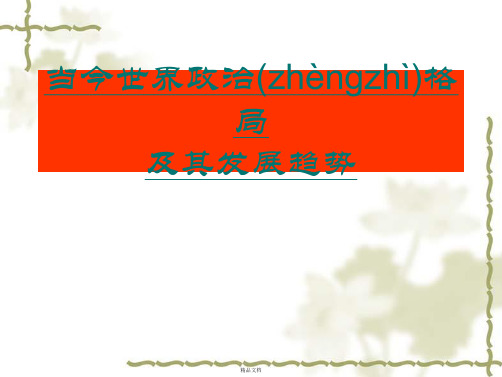
二、战后(zhàn hòu)两极格局的形成与 演变
1.雅尔塔体制的建立和两大阵营的对峙 (1)雅尔塔体制的建立 雅尔塔体制的主要制定者是美国总统罗斯福和
苏联领导人斯大林,它是美苏两个大国安排世 界,划分(huà fēn)势力范围的结果。
精品文档
1.雅尔塔体制的建立和两大阵营的对峙 (2)两大阵营的对峙(冷战) 杜鲁门上台以后,逐步采取了一系列恶化美苏
精品文档
(10)“两超多强”说
和上世纪相比,美国的霸权显然日渐 式微。但至少从中短期来看,无法想象中 国可能取代美国行使压倒性霸权。美中一 方面反对对立,反复合作,另一方面不得 不把与七国集团和金砖国家(guójiā)合作协 商的“两超多强”这种“大国治理下的和 平”格局作为国际政治的主调。
大国权力的全部特征:军事(jūnshì)的、经济
的,以及约瑟夫·奈和其他人所说的意识形态
或文化权力的‘软’权力特征。”
精品文档
法国(fǎ ɡuó)战略研究基金会教授布鲁·泰尔特雷:
❖ “完全有理由认为,几十年内无任何国家能挑战美国的优势地 位。”
❖ 美国社会有“持续的自我再生能力”,“美国的政治机制的稳定 性在世界上也绝无仅有”。
精品文档
(4)多极格局说 理查德•罗斯克兰斯(Richard Rosecrance) :未来世界将是迅速发展的多 极——四个或五个主要因素在这个体系中居 支配地位(dìwèi)。 郗润昌:两极格局终结至今,以美、欧、日、 中、俄五大力量为主体的世界多极格局的框架 结构已基本形成。
精品文档
❖ 墨西哥报刊(bàokān)认为,2003年的伊 拉克战争打碎了凯南所预见的多极秩序(苏、 英、德、日、美),催生了一个非常复杂的多 极和多维世界,新生的六极世界看来已经出现: 美、欧盟、巴西、俄、印、中。
论世界政治格局多极化趋势
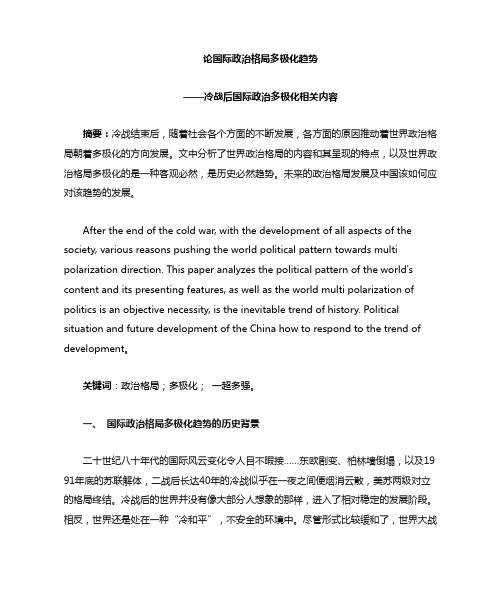
论国际政治格局多极化趋势——冷战后国际政治多极化相关内容摘要:冷战结束后,随着社会各个方面的不断发展,各方面的原因推动着世界政治格局朝着多极化的方向发展。
文中分析了世界政治格局的内容和其呈现的特点,以及世界政治格局多极化的是一种客观必然,是历史必然趋势。
未来的政治格局发展及中国该如何应对该趋势的发展。
After the end of the cold war, with the development of all aspects of the society, various reasons pushing the world political pattern towards multi polarization direction. This paper analyzes the political pattern of the world's content and its presenting features, as well as the world multi polarization of politics is an objective necessity, is the inevitable trend of history. Political situation and future development of the China how to respond to the trend of development。
关键词:政治格局;多极化;一超多强。
一、国际政治格局多极化趋势的历史背景二十世纪八十年代的国际风云变化令人目不暇接……东欧剧变、柏林墙倒塌,以及19 91年底的苏联解体,二战后长达40年的冷战似乎在一夜之间便烟消云散,美苏两级对立的格局终结。
冷战后的世界并没有像大部分人想象的那样,进入了相对稳定的发展阶段。
相反,世界还是处在一种“冷和平”,不安全的环境中。
经济全球化的极化效应与世界格局的和平转移
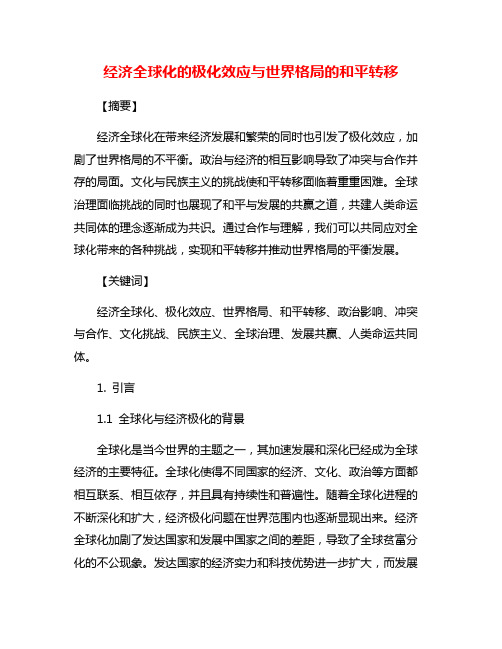
经济全球化的极化效应与世界格局的和平转移【摘要】经济全球化在带来经济发展和繁荣的同时也引发了极化效应,加剧了世界格局的不平衡。
政治与经济的相互影响导致了冲突与合作并存的局面。
文化与民族主义的挑战使和平转移面临着重重困难。
全球治理面临挑战的同时也展现了和平与发展的共赢之道,共建人类命运共同体的理念逐渐成为共识。
通过合作与理解,我们可以共同应对全球化带来的各种挑战,实现和平转移并推动世界格局的平衡发展。
【关键词】经济全球化、极化效应、世界格局、和平转移、政治影响、冲突与合作、文化挑战、民族主义、全球治理、发展共赢、人类命运共同体。
1. 引言1.1 全球化与经济极化的背景全球化是当今世界的主题之一,其加速发展和深化已经成为全球经济的主要特征。
全球化使得不同国家的经济、文化、政治等方面都相互联系、相互依存,并且具有持续性和普遍性。
随着全球化进程的不断深化和扩大,经济极化问题在世界范围内也逐渐显现出来。
经济全球化加剧了发达国家和发展中国家之间的差距,导致了全球贫富分化的不公现象。
发达国家的经济实力和科技优势进一步扩大,而发展中国家面临着贫困、失业、环境污染等问题,经济发展不平衡的矛盾也在逐渐加剧。
全球化与经济极化的背景中还存在着一些国际政治、文化等方面的挑战和矛盾。
发达国家在全球化进程中占据主导地位,通过跨国公司、国际金融机构等渠道主导着全球经济的发展方向,这导致了全球经济秩序的不公平和不稳定。
不同文化和民族之间的碰撞和冲突也在全球化背景下愈发显现。
这些问题的存在使得全球化与经济极化之间的关系更加复杂化,也给世界格局的和平转移带来了新的挑战。
1.2 世界格局的演变世界格局的演变是一个复杂而多变的过程,受到历史、政治、经济等多种因素的影响。
随着社会的不断发展,世界各国之间的力量对比也在不断变化。
在过去的几个世纪中,欧洲被认为是世界的霸主,而亚洲、非洲和拉丁美洲等地区则处于相对较弱的地位。
随着工业革命的兴起和新兴经济体的崛起,世界格局逐渐发生了变化。
单极化多极化还是无极化
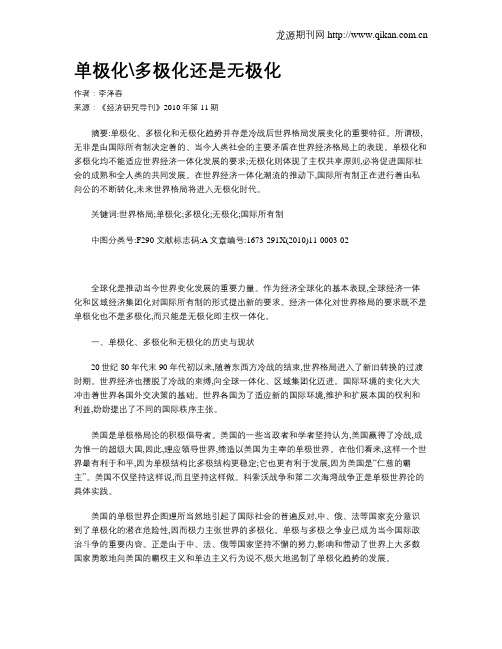
单极化\多极化还是无极化作者:李泽春来源:《经济研究导刊》2010年第11期摘要:单极化、多极化和无极化趋势并存是冷战后世界格局发展变化的重要特征。
所谓极,无非是由国际所有制决定着的、当今人类社会的主要矛盾在世界经济格局上的表现。
单极化和多极化均不能适应世界经济一体化发展的要求;无极化则体现了主权共享原则,必将促进国际社会的成熟和全人类的共同发展。
在世界经济一体化潮流的推动下,国际所有制正在进行着由私向公的不断转化,未来世界格局将进入无极化时代。
关键词:世界格局;单极化;多极化;无极化;国际所有制中图分类号:F290 文献标志码:A文章编号:1673-291X(2010)11-0003-02全球化是推动当今世界变化发展的重要力量。
作为经济全球化的基本表现,全球经济一体化和区域经济集团化对国际所有制的形式提出新的要求。
经济一体化对世界格局的要求既不是单极化也不是多极化,而只能是无极化即主权一体化。
一、单极化、多极化和无极化的历史与现状20世纪80年代末90年代初以来,随着东西方冷战的结束,世界格局进入了新旧转换的过渡时期。
世界经济也摆脱了冷战的束缚,向全球一体化、区域集团化迈进。
国际环境的变化大大冲击着世界各国外交决策的基础。
世界各国为了适应新的国际环境,维护和扩展本国的权利和利益,纷纷提出了不同的国际秩序主张。
美国是单极格局论的积极倡导者。
美国的一些当政者和学者坚持认为,美国赢得了冷战,成为惟一的超级大国,因此,理应领导世界,缔造以美国为主宰的单极世界。
在他们看来,这样一个世界最有利于和平,因为单极结构比多极结构更稳定;它也更有利于发展,因为美国是“仁慈的霸主”。
美国不仅坚持这样说,而且坚持这样做。
科索沃战争和第二次海湾战争正是单极世界论的具体实践。
美国的单极世界企图理所当然地引起了国际社会的普遍反对,中、俄、法等国家充分意识到了单极化的潜在危险性,因而极力主张世界的多极化。
单极与多极之争业已成为当今国际政治斗争的重要内容。
世界格局多极化趋势不可逆转(精品文档)

世界格局多极化趋势不可逆转世界格局多极化趋势不可逆转二战后,世界逐渐形成了一美苏对抗为基本特征的两极政治格局。
20世纪90年代初,随着两极格局的瓦解,世界格局发生了深刻变化,世界政治格局出现了一些新的特征。
21世纪后,世界格局多极化趋势日益加强。
世界多极化是指在一定时期内对国际关系有突出影响的国家和国家集团相互作用而趋向于形成多级格局的一种发展趋势,是对主要政治力量在全球势力分布状态的一种反应。
世界格局多极化是国际关系发展的必然结果,是不以人的意志为转移的客观趋势。
一、世界格局的演变发展过程(一) 美苏两极对峙格局1943-1945年期间战时盟国领导人在德黑兰、雅尔塔、波茨坦会议上通过一系列的协定、声明、和备忘录等等一致确认对二战后世界秩序做了新的安排,即“雅尔塔体系”。
它是第二次世界大战结束后,大国之间力量对比和妥协的产物,标志着世界两极格局-美苏两极格局的形成。
二战结束后,世界范围的力量对比发生明显改变,欧洲中心地位彻底丧失,世界格局的重心不可扭转的转向了太平洋两岸,美苏两大国崛起,两国在经济政治上旗鼓相当。
随着美苏共同敌人的消失,昔日的盟友由合作转向了全面对抗。
政治上:①杜鲁门主义出台,标志着“冷战”的正式开始。
②1948年,柏林危机成为美苏“冷战”的第一高潮;1962年,古巴导弹危机是美苏“冷战”的第二次高潮经济上:①实施马歇尔计划,目的:援助西欧恢复经济,增强西欧遏制苏联的力量,加强美国对西欧的控制。
②苏联成立了经济互助委员会进行反击,以打破以美国为首的资本主义世界的经济封锁。
军事上:①美国倡建北约组织:为了遏制苏联,加强对西欧的控制,1949年,美、英等12国签订了《北大西洋公约》,实行集体防御,建立北约组织。
②苏联倡建华约组织:为了对抗北约,1955年,苏、波、捷、罗等八国签订了《华沙条约》,建立华约组织。
(二)世界格局出现多极化趋势20世纪90年代初,东欧剧变和苏联解体后,美国成为唯一的超级大国,两级格局结束,世界形势的总趋势是走向缓和,明显呈现出缓和与紧张,和平与动荡并存的局面。
世界格局的多极化发展趋势

世界格局的多极化发展趋势当今国际舞台风云变幻,虽然和平与发展是时代的主题,当今世界并不太平,和平问题没有得到解决,发展问题更加严重,原有的差距还在加大,两极分化更趋严重。
不公正不合理的国际政治经济旧秩序还没有根本改变。
霸权主义、强权政治依然存在并有新的发展。
一些国家继续扩大和强化军事同盟,加强军备建设,严重影响了国际安全与稳定。
一些国家以“人权”为借口干涉主权国家内政,甚至不惜使用武力,对国际形势和国际关系产生了极坏的影响。
局部战争和地区冲突出现新的起伏,因民族、领土、宗教、资源等引发的纷争和战乱不断。
人类社会经过几千年的发展,深刻地改变了地球的面貌,特别是近几个世纪以来科学技术迅猛发展,取得了前所未有的成就,世界也因此联系得更加紧密。
17世纪英国资产阶级革命揭开了世界近代史的序幕,资本主义以其巨大的优越性战胜了腐朽的封建制度,推动了生产力的飞速提高,许多国家纷纷走上了资本主义的强国之路。
20世纪新兴的社会主义诞生,在世界大舞台上扮演了重要角色。
第二次世界大战结束以后,在国际大舞台上活动的各种力量、各种力量之间的相互关系都发生了变化,世界格局也随之发生了变化。
以前苏联为首的社会主义阵营与以美国为首的资本主义阵营之间对峙的局面形成,世界分成两级世界,两大阵营在政治、经济、特别是军事上进行了长期的对抗,双方势均力敌,各有胜负。
两大阵营的对峙,实质上是美苏两大国家利益的争夺。
直到20世界80年代末90年代初,发生了东欧剧变,苏联解体,苏联在“冷战”中败下阵来,两极格局结束。
美国无疑成为现今世界上独一无二的超级大国,其强大的政治、经济、科技、军事等方面的实力,尚未有一个国家能与之匹敌。
美国必定会引领这个世界,但它是否会永久处在世界的领先地位?世界格局会一直沿着单极化方向发展吗?其实不然,多极化才是世界发展的趋势。
影响当今乃至未来世界格局的因素是多方面的,其中政治和经济的影响尤为突出。
多极化趋势主要包括:作为单极世界的超级大国美国呈现出相对衰退趋势,日、欧盟与美国的实力差距不断拉近趋势,中国的崛起加速趋势,俄罗斯的不断恢复趋势,发展中国家的上升趋势等。
“未来十年中国有望成为超级大国,世界将呈现两极化格局”
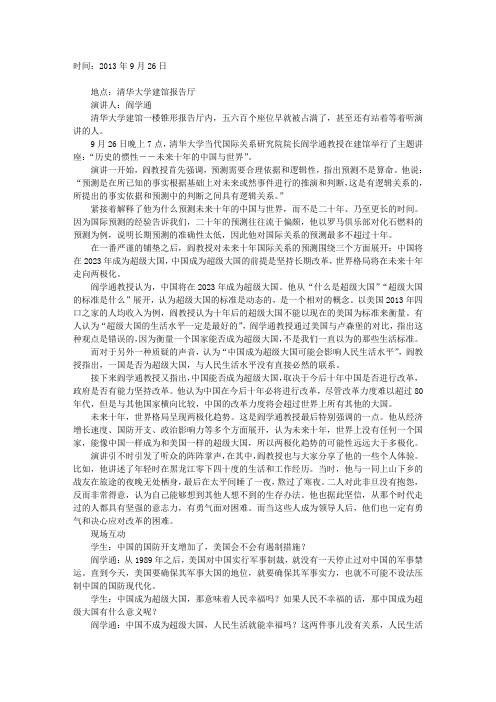
时间:2013年9月26日地点:清华大学建馆报告厅演讲人:阎学通清华大学建馆一楼锥形报告厅内,五六百个座位早就被占满了,甚至还有站着等着听演讲的人。
9月26日晚上7点,清华大学当代国际关系研究院院长阎学通教授在建馆举行了主题讲座:“历史的惯性――未来十年的中国与世界”。
演讲一开始,阎教授首先强调,预测需要合理依据和逻辑性,指出预测不是算命。
他说:“预测是在所已知的事实根据基础上对未来或然事件进行的推演和判断,这是有逻辑关系的,所提出的事实依据和预测中的判断之间具有逻辑关系。
”紧接着解释了他为什么预测未来十年的中国与世界,而不是二十年、乃至更长的时间。
因为国际预测的经验告诉我们,二十年的预测往往流于偏颇,他以罗马俱乐部对化石燃料的预测为例,说明长期预测的准确性太低,因此他对国际关系的预测最多不超过十年。
在一番严谨的铺垫之后,阎教授对未来十年国际关系的预测围绕三个方面展开:中国将在2023年成为超级大国,中国成为超级大国的前提是坚持长期改革,世界格局将在未来十年走向两极化。
阎学通教授认为,中国将在2023年成为超级大国。
他从“什么是超级大国”“超级大国的标准是什么”展开,认为超级大国的标准是动态的,是一个相对的概念。
以美国2013年四口之家的人均收入为例,阎教授认为十年后的超级大国不能以现在的美国为标准来衡量。
有人认为“超级大国的生活水平一定是最好的”,阎学通教授通过美国与卢森堡的对比,指出这种观点是错误的,因为衡量一个国家能否成为超级大国,不是我们一直以为的那些生活标准。
而对于另外一种质疑的声音,认为“中国成为超级大国可能会影响人民生活水平”,阎教授指出,一国是否为超级大国,与人民生活水平没有直接必然的联系。
接下来阎学通教授又指出,中国能否成为超级大国,取决于今后十年中国是否进行改革,政府是否有能力坚持改革。
他认为中国在今后十年必将进行改革,尽管改革力度难以超过80年代,但是与其他国家横向比较,中国的改革力度将会超过世界上所有其他的大国。
关于世界格局演变趋势与“无极化”世界的思考与探讨
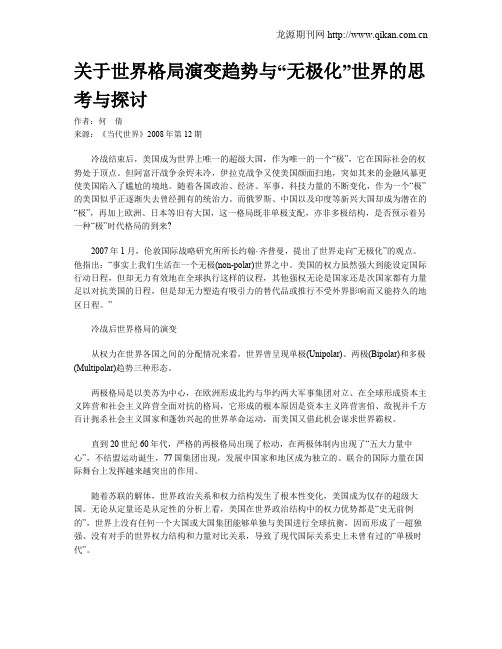
关于世界格局演变趋势与“无极化”世界的思考与探讨作者:何倩来源:《当代世界》2008年第12期冷战结束后,美国成为世界上唯一的超级大国,作为唯一的一个“极”,它在国际社会的权势处于顶点。
但阿富汗战争余烬未冷,伊拉克战争又使美国颜面扫地,突如其来的金融风暴更使美国陷入了尴尬的境地。
随着各国政治、经济、军事、科技力量的不断变化,作为一个“极”的美国似乎正逐渐失去曾经拥有的统治力。
而俄罗斯、中国以及印度等新兴大国却成为潜在的“极”,再加上欧洲、日本等旧有大国,这一格局既非单极支配,亦非多极结构,是否预示着另一种“极”时代格局的到来?2007年1月,伦敦国际战略研究所所长约翰·齐普曼,提出了世界走向“无极化”的观点。
他指出:“事实上我们生活在一个无极(non-polar)世界之中。
美国的权力虽然强大到能设定国际行动日程,但却无力有效地在全球执行这样的议程,其他强权无论是国家还是次国家都有力量足以对抗美国的日程,但是却无力塑造有吸引力的替代品或推行不受外界影响而又能持久的地区日程。
”冷战后世界格局的演变从权力在世界各国之间的分配情况来看,世界曾呈现单极(Unipolar)、两极(Bipolar)和多极(Multipolar)趋势三种形态。
两极格局是以美苏为中心,在欧洲形成北约与华约两大军事集团对立、在全球形成资本主义阵营和社会主义阵营全面对抗的格局,它形成的根本原因是资本主义阵营害怕、敌视并千方百计扼杀社会主义国家和蓬勃兴起的世界革命运动,而美国又借此机会谋求世界霸权。
直到20世纪60年代,严格的两极格局出现了松动,在两极体制内出现了“五大力量中心”,不结盟运动诞生,77国集团出现,发展中国家和地区成为独立的、联合的国际力量在国际舞台上发挥越来越突出的作用。
随着苏联的解体,世界政治关系和权力结构发生了根本性变化,美国成为仅存的超级大国。
无论从定量还是从定性的分析上看,美国在世界政治结构中的权力优势都是“史无前例的”,世界上没有任何一个大国或大国集团能够单独与美国进行全球抗衡,因而形成了一超独强、没有对手的世界权力结构和力量对比关系,导致了现代国际关系史上未曾有过的“单极时代”。
毛概国际形势的发展及特点

这是时代进步的要求,符合各国
多 极 化 的 意 义
人民的利益多极化格局使世界各种力 量逐渐形成既相互借重又相互制约与 制衡的关系,有利于避免新的世界大 战的爆发,有利于遏制霸权主义和强 权政治,有利于建立公正合理的国际 政治经济新秩序,有利于实现各国人
元,成为美国历史上规模最大的金融救援计划。
美联银行所造成的混乱
美国时间9月29日早晨,美联银行的股价暴挫 90%。当时,花旗银行同意收购美联银行的 大部分资产。出人意料的是,四天后富国银 行竟宣布美联银行已经同意富国117亿美元的 收购请求。10月9日,花旗银行宣称其将终结 与美联银行的收购谈判。
2008年以来的危机表现: Indymac银行的倒闭
“两房”被接管
2008年9月7日的新闻发布会上,美财长亨利·保尔森以及 联邦住房金融局局长卢卡特(James B.Lockhart)准备宣布
接管房利美、房地美。 “两房”持有或担保的住房抵押贷款债券总额高达近5万 亿美元,而美国政府拯救“两房”的资金也达到了2000亿美
返 回
返 回
冷战结束以来,各种力量此消彼 长。虽然世界力量对比严重失衡, 但世界格局走向多极化的趋势越 来越清晰。一个超级大国和多种 力量并存,是多极化格局最终形 成前的较长过渡时期内世界力量 对比的基本态势。
我们必须认识到,苏联仍然是美国的一 个非常强大、有力和咄咄逼人的竞争者。 现在,当我们环顾我们所处的世界时,我们 美国已经不再出于十分突出的地位或者完全 占支配地位了……美国仍然是世界上最强、 最富的国家,但是,现在我们面临着这样一 种局面,另外四个潜在的经济力量……有能 力、有人可以在各个方面向我们挑战──即 使没有可以那样做的政府,至少有可以那样 做的人。
人教版高一历史必修一(教案)第27课 世纪之交的世界格局完美版
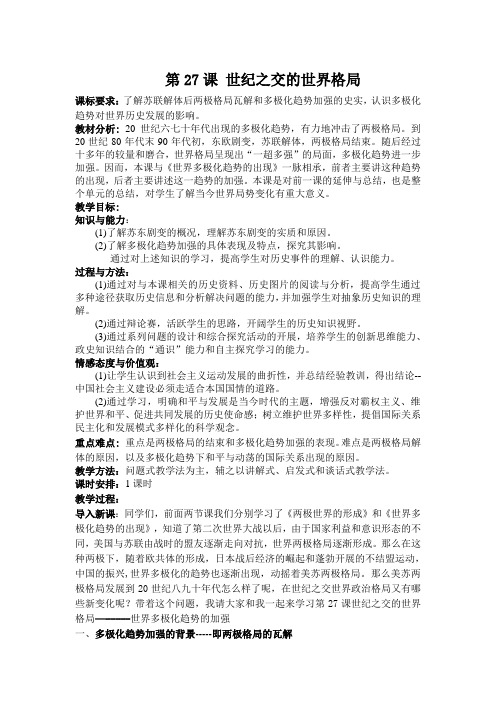
第27课世纪之交的世界格局课标要求:了解苏联解体后两极格局瓦解和多极化趋势加强的史实,认识多极化趋势对世界历史发展的影响。
教材分析:20世纪六七十年代出现的多极化趋势,有力地冲击了两极格局。
到20世纪80年代末90年代初,东欧剧变,苏联解体,两极格局结束。
随后经过十多年的较量和磨合,世界格局呈现出“一超多强”的局面,多极化趋势进一步加强。
因而,本课与《世界多极化趋势的出现》一脉相承,前者主要讲这种趋势的出现,后者主要讲述这一趋势的加强。
本课是对前一课的延伸与总结,也是整个单元的总结,对学生了解当今世界局势变化有重大意义。
教学目标:知识与能力:(1)了解苏东剧变的概况,理解苏东剧变的实质和原因。
(2)了解多极化趋势加强的具体表现及特点,探究其影响。
通过对上述知识的学习,提高学生对历史事件的理解、认识能力。
过程与方法:(1)通过对与本课相关的历史资料、历史图片的阅读与分析,提高学生通过多种途径获取历史信息和分析解决问题的能力,并加强学生对抽象历史知识的理解。
(2)通过辩论赛,活跃学生的思路,开阔学生的历史知识视野。
(3)通过系列问题的设计和综合探究活动的开展,培养学生的创新思维能力、政史知识结合的“通识”能力和自主探究学习的能力。
情感态度与价值观:(1)让学生认识到社会主义运动发展的曲折性,并总结经验教训,得出结论--中国社会主义建设必须走适合本国国情的道路。
(2)通过学习,明确和平与发展是当今时代的主题,增强反对霸权主义、维护世界和平、促进共同发展的历史使命感;树立维护世界多样性,提倡国际关系民主化和发展模式多样化的科学观念。
重点难点:重点是两极格局的结束和多极化趋势加强的表现。
难点是两极格局解体的原因,以及多极化趋势下和平与动荡的国际关系出现的原因。
教学方法:问题式教学法为主,辅之以讲解式、启发式和谈话式教学法。
课时安排:1课时教学过程:导入新课:同学们,前面两节课我们分别学习了《两极世界的形成》和《世界多极化趋势的出现》,知道了第二次世界大战以后,由于国家利益和意识形态的不同,美国与苏联由战时的盟友逐渐走向对抗,世界两极格局逐渐形成。
新高考英语题型精析精练与话题拓展:话题拓展02.人工智能(解析版)
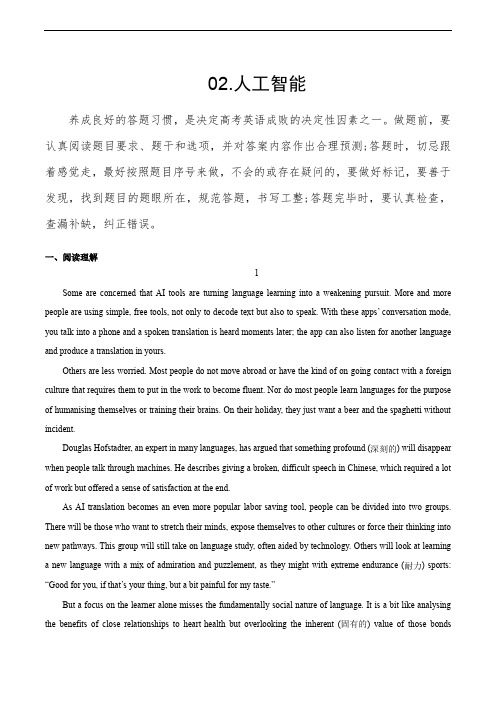
02.人工智能养成良好的答题习惯,是决定高考英语成败的决定性因素之一。
做题前,要认真阅读题目要求、题干和选项,并对答案内容作出合理预测;答题时,切忌跟着感觉走,最好按照题目序号来做,不会的或存在疑问的,要做好标记,要善于发现,找到题目的题眼所在,规范答题,书写工整;答题完毕时,要认真检查,查漏补缺,纠正错误。
一、阅读理解1Some are concerned that AI tools are turning language learning into a weakening pursuit. More and more people are using simple, free tools, not only to decode text but also to speak. With these apps’ conversation mode, you talk into a phone and a spoken translation is heard moments later; the app can also listen for another language and produce a translation in yours.Others are less worried. Most people do not move abroad or have the kind of on-going contact with a foreign culture that requires them to put in the work to become fluent. Nor do most people learn languages for the purpose of humanising themselves or training their brains. On their holiday, they just want a beer and the spaghetti without incident.Douglas Hofstadter, an expert in many languages, has argued that something profound (深刻的) will disappear when people talk through machines. He describes giving a broken, difficult speech in Chinese, which required a lot of work but offered a sense of satisfaction at the end.As AI translation becomes an even more popular labor-saving tool, people can be divided into two groups. There will be those who want to stretch their minds, expose themselves to other cultures or force their thinking into new pathways. This group will still take on language study, often aided by technology. Others will look at learning a new language with a mix of admiration and puzzlement, as they might with extreme endurance (耐力) sports: “Good for you, if that’s your thing, but a bit painful for my taste.”But a focus on the learner alone misses the fundamentally social nature of language. It is a bit like analysing the benefits of close relationships to heart-health but overlooking the inherent (固有的) value of those bondsthemselves. When you try to ask directions in broken Japanese or ruin a joke in broken German, you are making direct contact with someone. And when you speak a language well enough to tell a story with perfect timing or put delicate differences on an argument, that connection is more profound still. The best relationships do not require a medium.1. What is the first two paragraphs mainly about?A. Communicating through apps is simple.B. Apps provide a one-way interactive process.C. Using apps becomes more and more popular.D. AI tools weaken the needs of language learning.2. What is Douglas’ attitude to language learning?A. Favorable.B. Objective.C. Doubtful.D. Unclear3. What do we know about the second group mentioned in paragraph 4?A. They are keen on foreign culture.B. They long to join in endurance sports.C. They find Al tools too complex to operate.D. They lack the motivation to learn language.4. How does the author highlight his argument in the last paragraph?A. By providing examples.B. By explaining concepts.C. By stating reasons.D. By offering advice.【答案】1. D 2. A 3. D 4. A【解析】这是一篇说明文。
09:《当今世界政治格局的多极化趋势》
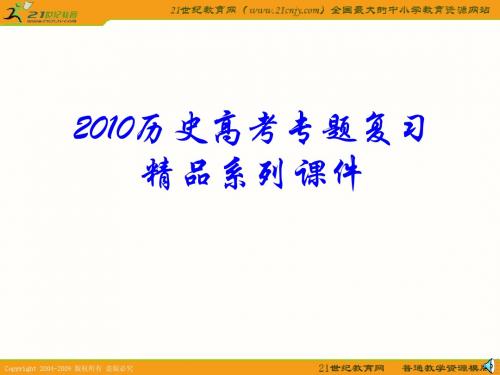
Copyright 2004-2009 版权所有 盗版必究
欧洲人的欧洲
(1)欧洲走向联合的原因: 欧洲走向联合的原因: A.工业生产恢复战前水平 为了摆脱美国控制,进一步发展经济。 工业生产恢复战前水平, A.工业生产恢复战前水平,为了摆脱美国控制,进一步发展经济。 B.重振西欧的国际地位 对抗美苏,重新在国际事务中发挥作用。 重振西欧的国际地位, B.重振西欧的国际地位,对抗美苏,重新在国际事务中发挥作用。 (2)形成过程: 形成过程: 欧洲联合的影响: (3)欧洲联合的影响: 1、促进成员国经济的发展,国际地位的提高; 、促进成员国经济的发展,国际地位的提高; 2、使世界力量对比发生了部分变化,冲击着美苏两极格局; 、使世界力量对比发生了部分变化,冲击着美苏两极格局;
Copyright 2004-2009 版权所有 盗版必究
“冷战”对峙的形成过程: 冷战”对峙的形成过程:
美国的“冷战” 资本主义阵营) 苏联的反击(社会主义阵营) 美国的“冷战”(资本主义阵营) 苏联的反击(社会主义阵营) 揭幕: 丘吉尔”铁幕”演说) ①揭幕: (丘吉尔”铁幕”演说) 政治: ②政治:杜鲁门主义 共产党和工人党情报局成立 1947.3) (1947.3) (1947.9) 1947.9) 经济: ③经济: 马歇尔计划 经济互助委员会成立 1947.6) (1947.6) 1949.1) (1949.1) 军事: ④军事: 北约的成立 华约的成立 1949) (1949) 1955) (1955) 两极对峙局面最终形成 什么是冷战? 什么是冷战? 冷战是指二战后美苏双方以及东西方之间在政治、军事、经济、 冷战是指二战后美苏双方以及东西方之间在政治、军事、经济、 是指二战后美苏双方以及东西方之间在政治 外交、文化、意识形态诸方面除诉诸战争之外的紧张对峙和对抗。 外交、文化、意识形态诸方面除诉诸战争之外的紧张对峙和对抗。
岳麓版必修1练习:第22课 社会主义政治建设的曲折发展 Word版含解析
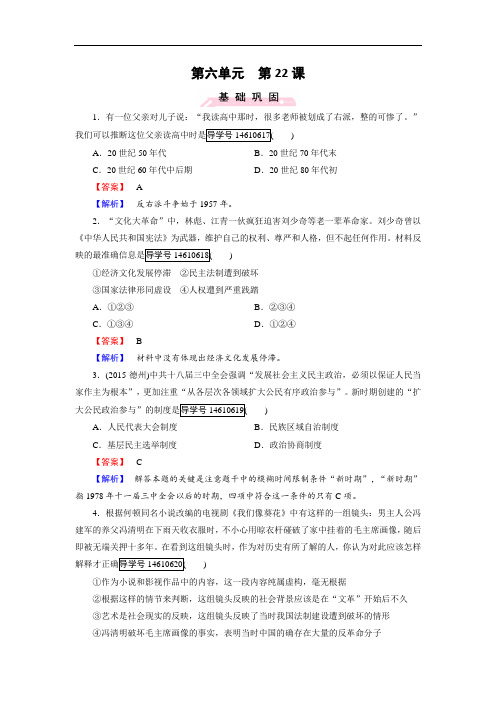
第六单元第22课1.有一位父亲对儿子说:“我读高中那时,很多老师被划成了右派,整的可惨了。
”)A.20世纪50年代B.20世纪70年代末C.20世纪60年代中后期D.20世纪80年代初【答案】 A【解析】反右派斗争始于1957年。
2.“文化大革命”中,林彪、江青一伙疯狂迫害刘少奇等老一辈革命家。
刘少奇曾以《中华人民共和国宪法》为武器,维护自己的权利、尊严和人格,但不起任何作用。
材料反)①经济文化发展停滞②民主法制遭到破坏③国家法律形同虚设④人权遭到严重践踏A.①②③B.②③④C.①③④D.①②④【答案】 B【解析】材料中没有体现出经济文化发展停滞。
3.(2015·德州)中共十八届三中全会强调“发展社会主义民主政治,必须以保证人民当家作主为根本”,更加注重“从各层次各领域扩大公民有序政治参与”。
新时期创建的“扩)A.人民代表大会制度B.民族区域自治制度C.基层民主选举制度D.政治协商制度【答案】 C【解析】解答本题的关键是注意题干中的模糊时间限制条件“新时期”,“新时期”指1978年十一届三中全会以后的时期,四项中符合这一条件的只有C项。
4.根据何顿同名小说改编的电视剧《我们像葵花》中有这样的一组镜头:男主人公冯建军的养父冯清明在下雨天收衣服时,不小心用晾衣杆碰破了家中挂着的毛主席画像,随后即被无端关押十多年。
在看到这组镜头时,作为对历史有所了解的人,你认为对此应该怎样)①作为小说和影视作品中的内容,这一段内容纯属虚构,毫无根据②根据这样的情节来判断,这组镜头反映的社会背景应该是在“文革”开始后不久③艺术是社会现实的反映,这组镜头反映了当时我国法制建设遭到破坏的情形④冯清明破坏毛主席画像的事实,表明当时中国的确存在大量的反革命分子A.②③B.①④C.②④D.①②③④【答案】 A【解析】小说和影视作品取材于现实生活,并非毫无根据,排除含①的选项,④明显不对,排除C项。
5.据中国新闻网报道,长沙市市民李先生在家中整理物品时,发现一张其母亲跳“忠”字舞的照片。
致2050年人们的一封信英语作文

致2050年人们的一封信英语作文英文回答:Dear People of 2050,。
As I sit here in the year 2023, I can only imagine the profound changes that the intervening decades will bring. Technological advancements, societal shifts, and global challenges will undoubtedly reshape your world in ways that we can scarcely fathom today.Yet, amidst the uncertainty, certain fundamental values and questions remain timeless. In this letter, I will attempt to answer some of the questions that you may have about the world we leave behind:What were the greatest challenges facing humanity in 2023?The world of 2023 grappled with a multitude offormidable challenges, including climate change, economic inequality, political polarization, and the threat of nuclear war. These issues demanded urgent attention and collective action.What technological innovations will shape the future?Rapid advancements in artificial intelligence, robotics, and biotechnology held the promise of transforming every aspect of human life. However, the verantwortung (responsibility) that comes with these innovations must be carefully considered.What is the future of work and education?The changing nature of work automation and remote work will necessitate new approaches to education and job training. Lifelong learning and adaptability will becrucial to navigate the evolving job market.How will society be organized?The rise of social media and global interconnectedness will continue to shape social norms and political discourse. The boundaries between communities and cultures will become increasingly blurred.What is the role of the individual in the face ofthese changes?In an era of rapid transformation, it is more important than ever to cultivate resilience, critical thinking, and a sense of purpose. Collective action and civic engagementwill be essential to address the challenges and seize the opportunities that lie ahead.What lessons have we learned from the past?As humanity has faced numerous obstacles throughout history, we have also gained valuable lessons. Learningfrom past successes and failures will be vital as you navigate the complexities of your own time.What is the ultimate goal of human existence?This question has been pondered by philosophers and theologians for millennia. Ultimately, it is up to each individual to determine their own purpose and meaning in life.In closing, let me express my hope that you will embrace the challenges and opportunities that the future holds with the same resilience and ingenuity that has characterized humanity throughout our history. May you create a world that is more just, equitable, and sustainable for generations to come.中文回答:2050年的人们,你们好!当我在2023年写下这些文字时,我只能想象在接下来几十年的时间里,世界将会发生怎样的深刻变化。
论冷战后世界格局向多极化转变的具体表现与特点之欧阳地创编

论冷战后世界格局向多极化转变的具体表现与特点作者:仇晓璐 084264内容提要:从20世纪90年代初起,随着苏联解体,欧、日崛起和第三世界实力的总体上升,世界历史正日益朝着多极化的方向演进。
这虽非是定势,但却是一种不可逆转的趋势。
此外,这种趋势在全球的各个领域都有发展,并正朝着牵制、反对美霸权主义强权政治的方向前行。
关键词:国际格局多极化单极化一.世界格局由单极向多极转化的具体表现首先,这种转化表现在美国在全球事务中的绝对霸主地位的淡去。
1990年8月至1991年2月,美国借伊拉克人侵科威特从而引发海湾危机之机,凭借强大的军事优势取得了巨大的胜利,使美国的军威和国威大振,美国总统乔治·布什提出了建立"世界新秩序"的构想,开始构建冷战后的美国全球新战略--世界新秩序战略,表现出强烈的世界单极化倾向。
但在冷战后的世纪之交,特别是在经历了“9.11”恐怖袭击之后,美国仿佛是被人当头一棒,脚步日益不稳。
随着世界力量的再分配,美国目前对于世界其他国家的优势正在逐步消失。
因为当今世界所面临的一些问题,更多的,是关系到所以世界公民切身利害的,相当复杂的难关。
好比最近的经济危机、能源问题、环保问题等,这已不是由美国“大哥”一声令下就能解决的,它需要各国的通力合作,甚至是要求一些国家做出相对让步和牺牲方可达到的。
而若美一直死守着独霸主义的话,那必将是逆潮流的,与世界人民意愿相左的。
又如在台湾问题上,即使有美国的暗中帮助,但是“分裂国家主权,否认一个中国”在国际社会中是站不住脚的,必将受到世界人民的谴责,“台独”的妄言毕竟破碎。
其次,欧盟和日本的迅速恢复和崛起也加快了多极化的势头。
冷战时期美国在欧洲推行“马歇儿计划”,掌控主要盟国的基础是西欧和日本的言听计从。
冷战的终结对美国来说,失去的不仅是昔日的对手,还有昔日联合盟国共同对敌的号召力和凝聚力。
冷战后时代是一个经济和科技主沉浮的时代,欧盟国家和日本对美国"保护伞"的需求程度大大下降,美国军事优势的作用也就大打折扣。
世 界 多 极 化 趋 势 的 四 个 维 度
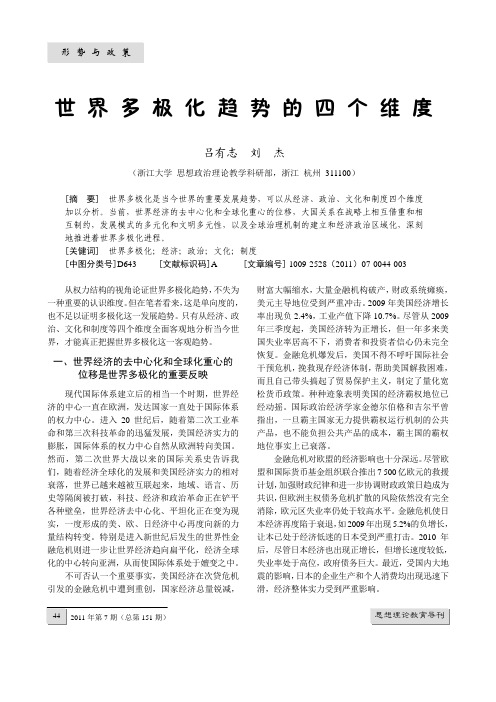
形势与政策世 界 多 极 化 趋 势 的 四 个 维 度吕有志 刘 杰(浙江大学思想政治理论教学科研部,浙江杭州 311100)[摘 要]世界多极化是当今世界的重要发展趋势,可以从经济、政治、文化和制度四个维度加以分析。
当前,世界经济的去中心化和全球化重心的位移,大国关系在战略上相互借重和相互制约,发展模式的多元化和文明多元性,以及全球治理机制的建立和经济政治区域化,深刻地推进着世界多极化进程。
[关健词]世界多极化;经济;政治;文化;制度[中图分类号]D643 [文献标识码]A [文章编号] 1009-2528(2011)07-0044-003从权力结构的视角论证世界多极化趋势,不失为一种重要的认识维度。
但在笔者看来,这是单向度的,也不足以证明多极化这一发展趋势。
只有从经济、政治、文化和制度等四个维度全面客观地分析当今世界,才能真正把握世界多极化这一客观趋势。
一、世界经济的去中心化和全球化重心的位移是世界多极化的重要反映现代国际体系建立后的相当一个时期,世界经济的中心一直在欧洲,发达国家一直处于国际体系的权力中心。
进入20世纪后,随着第二次工业革命和第三次科技革命的迅猛发展,美国经济实力的膨胀,国际体系的权力中心自然从欧洲转向美国。
然而,第二次世界大战以来的国际关系史告诉我们,随着经济全球化的发展和美国经济实力的相对衰落,世界已越来越被互联起来,地域、语言、历史等隔阂被打破,科技、经济和政治革命正在铲平各种壁垒,世界经济去中心化、平坦化正在变为现实,一度形成的美、欧、日经济中心再度向新的力量结构转变。
特别是进入新世纪后发生的世界性金融危机则进一步让世界经济趋向扁平化,经济全球化的中心转向亚洲,从而使国际体系处于嬗变之中。
不可否认一个重要事实,美国经济在次贷危机引发的金融危机中遭到重创,国家经济总量锐减,财富大幅缩水,大量金融机构破产,财政系统瘫痪,美元主导地位受到严重冲击。
2009年美国经济增长率出现负2.4%,工业产值下降10.7%。
- 1、下载文档前请自行甄别文档内容的完整性,平台不提供额外的编辑、内容补充、找答案等附加服务。
- 2、"仅部分预览"的文档,不可在线预览部分如存在完整性等问题,可反馈申请退款(可完整预览的文档不适用该条件!)。
- 3、如文档侵犯您的权益,请联系客服反馈,我们会尽快为您处理(人工客服工作时间:9:00-18:30)。
未来世界格局将走向无极化(The future world pattern will be nopolarization)The future world pattern will be "no polarization"""It should be sent to Pantheon in eighteenth Century."The French Revolution famous politician sanjust (Saint-Just) once wrote that. Sanjust live only a short 28 years old, he did not see the changes after 19, occurred on twentieth Century, but it is impossible to anticipate what happened intwenty-first Century 10 year change head.What has happened to the world in the first 10 years of the past twenty-first Century? The vocabulary is often more than the loud testimony "in the history of the British historian Eric Hobsbawm in accordance with the reduction method, we can write down the words: Hurricane and bubble unilateralism, terrorism and financial leverage rupture, economic recession and debt crisis, globalization and the Middle East situation, backward, rising of BRICs the world, the transfer of power, from the sovereign state to private and social media against the ecological crisis, the polarization of wealth and the middle class, and aggravated the environmental movement as one falls, another rises" the end of history ", as well as the fashion and self correction, the concept of" soft power "after the" smart power "concept highlights...... It can be said that the face of the world showing a hitherto unknown change constantly like cloud and wave.Marked by the replacement of the leaders of major world powers,the world stood on a new starting point in 2013. What will the world and China look like in the next 10 years? We believe that, listen to the history sound pulse trend, helps us to create a new season, for. To this end, this newspaper launched the "Chinese from this period and the world" series of interviews in the next 10 years, invite domestic and foreign well-known scholars to discuss the future of 10 years of power game and global governance, the world economy, Chinese culture and world ecological development and other topics. This period "Wenhui scholar interview" vice president, director of the Institute of Shanghai Academy of Social Sciences History Research researcher Huang Renwei interview is opening.Huang Renwei was one of the main participants in the important issue of "China's peaceful rise". As early as 2002, he published a monograph entitled "time and space for the rise of China". Looking forward to the future, Huang Renwei believes that in the next 10 years, China will need a process of adaptation and capacity development, and the outside world needs a process of adapting to China and psychological adjustment. Over the past10 years, China and the international community have come toa more stable view of their own responsibilities, rights and interests in global governance.Multipolarization is an important trend in the development of the world today. Huang Renwei believes that the future of the world is the emergence of a group of more than the polarization of the "pole", will be "no polarization."". There is a large, medium and small power structure in different regions, and different regions are combined into large, medium and small structures around the world. The world rely on such a structureis a step toward a harmonious stable until.Huang Renwei has served as the research center of the State Council Taiwan Affairs Office of Shanghai municipal government, distinguished fellow experts, consultation and deputy director of the Shanghai Institute of international relations of the American Economic Association executive director, executive director of the Institute of the history of the United States and other duties, the author of "the American west land system evolution" "independent foreign policy of peace", co-author of "China international status report" "state sovereignty theory".We may overestimate the negative consequences of America's "strategic rebalancing"Wen Wei Po: over the next 10 years, will the process of the rise of the west be truly reversed since the industrial revolution?Huang Renwei: for 10 years, we still can not draw the conclusion of this question. Because the West has been on the stage of the world for three hundred or four hundred years, the real rapid growth of emerging countries is still nearly 20 years. As far as economic aggregate is concerned, the proportion of emerging countries in the world economy is less than 20%, and about 65% in the western countries. Even half and half can't do it in 10 years. Most important of all, for emerging countries, the rules of the international system and the power and the right to speak out the rules, that is, the rise of the so-called "soft power",Longer than the economy's total catch. But Western influenceis on the decline, and non Western influence is on the rise, which is an irreversible direction. This trend can be seen in several ways.First of all, the Western wealth has a negative growth trend, and its own creation of wealth is not enough to support its own consumption, the emergence of a worldwide debt crisis in developed countries. The European Union's debt is equal to 95% of its GDP, the US debt is 100% of its GDP, and Japan's debt is 200% of its GDP. In the medium and long term, the positive forecast is that the debt growth is slowing down, and the bad result is that the debt growth is much faster than the growth of the total amount of the economy.Second, there is likely to be a "zero growth" of the western economy. Whether it is the real economy or the virtual economy, its growth is lack of motivation. To some extent, this is the globalization of the western economy". In the past 20 years, Japan's economy has been characterized by "two zero": zero interest rates and zero growth. If the western economy presents two features in the next 5 to 10 years, the "Japanese disease" after the bursting of the bubble will spread throughout the west.Third, if the first two problems can not be improved, then the whole western social security system is bound to go wrong. The three guarantees of pension insurance, medical insurance and unemployment insurance are the basic conditions for the stability of Western society after World War ii.In my opinion, the three problems will be more serious in thenext 5 to 10 years.Wen Wei Po: will the US hegemony end in the next 10 years? The conservative powers and emerging powers can contribute to a "new powers"?Huang Renwei: "new great power relationship" was put forward by china. Synonymous with so-called "big power" is the hegemony, mastery of world domination power is hegemony.Historically, there are only two countries that can maintain and maintain world hegemony in the capitalist market: Britain and the United states. The forms and contents of the two hegemony are different. The core of British hegemony is its global colonial system. There are two cores of American hegemony, one is military hegemony composed of Allied military base system, the other is world currency system with the dollar as the core. Moreover, military hegemony is supported by the hegemony of the dollar.British hegemony began to decline in the first World War, and ended in the 50s of the last century. The reason lies in the rise of the world liberation movement after World War II, which led to the collapse of the British colonial system and the end of British hegemony.Similarly, the American hegemony depends on whether its allies and the dollar system can be maintained. George W. Bush's unilateralism has shaken American allies. Now, the United States implements "soft power" and "smart power", and unilateralism has little convergence, and the allied system isalso slightly stable. If the United States insists on military unilateralism, its allies will gradually move away from it; if the United States abuses its credit, unlimited quantitative easing will destabilize the dollar system. Obviously, the biggest factor of shaking American hegemony is the policy of the United States itself.Germany and Japan have challenged Britain, and the Soviet Union has challenged the United States without success. Britain, or the United States, is the cause of the rise and fall of its hegemony. If this logic holds, can explain the relationship between the so-called "conservative countries" and "change" state. The main task of the so-called "emerging countries" is not to challenge the United States. Their main strength is not to change the status quo, but to adapt to the international system, and to amend the international system in the process. Whether the system will produce a real mutation depends on the dominant player in the system. When it can not be maintained, the system naturally changes. The United States is worried about China's challenge and replaces it, which is not the core of the problem. The real worry is how America avoids historical mistakes. There are two so-called historical errors, is a mistake makers are unaware of their own cause, once realized that as irreversible, the disintegration of the Soviet Union, the British colonial system collapse;Two, the person who makes mistakes is often so powerful that there is no power to stop it.Wen Wei Po: in the next 10 years, how much will the strategic rebalancing of the United States change the global strategy?Huang Renwei: some time ago, we overestimated the negative consequences of "strategic rebalancing" or "return to Asia". In my opinion, the rebalancing strategy of the United States' return to Asia is a strategy of "going forward and retreating". It is also an economic strategy with "military as a coat", or "market strategy under the cloak of security"". These two are ignored by many people.First of all, it is the global balance of American military forces to pull out of the Middle East and get rid of the burden of two wars in Iraq and afghanistan. This has brought about an upward balance of power against China in asia. Thus, this is not the first step against China's balance, but the need to pull out of the middle east. Second, in the whole western Pacific, the United States pushed Asian countries to the front line and retreated to the second line, increasing the frictions within the Asian countries on the front line. Third, when Asian countries have increased their internal friction on the first line, their security needs have risen, and they have become more dependent on American protection. The United States has access to the forefront of Asia at any time. Fourth, when Asian countries are tied to the American defense system, the United States will tie the markets of Asian countries to the economic interests of the United states. The TPP, which the United States dished out, requires Asian countries to be fully open to trade in services, but the United States has imposed barriers to Asian countries on commodity trade. This is obviously American unilateralism in regional integration. If we simply look at it from the surface, it is easy to regard the rebalancing strategy of the United States as a new cold war strategy, and from theabove several points of view, it is more comprehensive.Now the rebalancing strategy in the United States has also had a negative effect. First, the Middle East countries have not solved the problem, the United States can not retreat all over. Israel and the European Union are reluctant to move all of America to East asia. Two, when the conflict between the first Asian countries is fierce, the United States can not really protect these Asian companions. If it is involved in all conflicts in the Western Pacific, it also violates the strategic interests of the United states. Three, TPP has encountered obstacles, including Japan, South Korea, including the Asian countries to join, there are great concerns. Obama said, "TPP in a year.". Now, two or three years have passed, and the more we go, the more we can't do it. Therefore, the United States' strategy to return to Asia has encountered a bottleneck. Now, even within the United States, a lot of insight in the American strategic community has criticized Hilary for turning the United States back into asia. I believe in Obama's new term, he will rethink this question.Wen Wei Po: what are the prospects for the EU integration process in the next 10 years?Huang Renwei: This is a directional problem in the future of the political economy of the world. First of all, the European Union was a typical model of regional integration. If this model is successful, the shape of the country may change very much in the future. But the structural flaws in the European Union have been fully exposed since the global financial crisis. The interests of sovereign states have begun to exceed the commoninterests of the European Union to some extent. Part of the debt state and some creditor countries in the interests of the crack is very large, the EU's prospects have emerged in a very worrying state.The EU cannot afford to return to sovereign states. If we turn back, it will not be the collapse of the European Union, but the collapse of the world economy. If the EU continues to move forward, several major changes will have to take place. First, countries should really pay their financial bills and establish the central finance of the European union. The two is that Germany plays a leading role in the European union. Whether Germany's Europe or Europe's Germany will become clearer. Three is the British withdrawal from the European union. As long as Britain stays in the European Union, the EU can not truly integrate. The pound is not the euro, and its interests do not really blend with the European union. Britain can not give up the pound. It was a legacy of wealth that the colonial system left behind,The British Empire concentrated the colony's wealth in London by the pound. That's the real reason Britain won't put pounds into euros. Therefore, the United Kingdom and the European Union can not really combine into one. If these three can be achieved, the European Union can break through the difficult position, become a higher level of financial integration of the European Union, diplomatic and military integration will follow.The role of non state actors in the global governance system is on the riseWen Wei Po: in the next 10 years, will terrorism be reduced as a counter global governance force?Huang Renwei: the root of terrorism is in the Middle East, and the root causes of instability in the Middle East are palestine. So, the central problem of the Middle East, the Palestinian issue if not a reasonable solution, the Middle East will not eliminate international terrorism. Conditions for the formation of an international terrorist organization as large as Ben Laden are now weakening. Ben Laden's power was bigger than when American troops supported him in Afghanistan against the Soviet union. At the same time, we should also see that Taliban has not been wiped out in Afghanistan, and there is a possibility of a resurgence. Fundamentalist Islamic groups have risen in many countries, from underground to public activities, and even to power. This has given terrorism a certain breeding ground and climate. Therefore, terrorism in the Middle East is not so simple that it can be eliminated.In addition, we now see another kind of terrorism that is emerging, that is, terrorism in developed countries. Shootings in the United States and Europe have become increasingly frequent and combined with extreme nationalism and racial xenophobia. We must not only see terrorism in the Middle East, but also terrorism in the west. As the rifts in the western social and economic systems are growing, terrorism will occur among the desperate. Terrorism in the world is an extreme manifestation of the irrational phenomena in the world order. The total elimination of terrorism depends on the fairness and rationality of the world order. This is difficult to achieve.Wen Wei Po: over the next 10 years, will the Middle East with a conflict still move towards better governance and sustainable economic growth?Huang Renwei: I think it's very difficult. First of all, looking at the whole of the Middle East, whether it is called the "spring of Arabia" or as a social upheaval, this social change is far from complete. It is a huge rupture of Islamic religion and institutions in the process of modernization, rather than a very regular progress. Like the aftermath of the earth's crust changes, it takes a long time to develop a new ecology, and aftershocks and new fractures will continue to occur after the break. The structural breakdown in the modernization of the Arabia world is in fact far from complete, including the countries that have already undergone the "spring of Arabia", including the United States occupied Iraq and afghanistan. The process will be long, and it is possible for decades to one hundred years. Second, this social change is a result of a large number of sectarian struggles and tribal struggles. The characteristic of sectarian struggle and tribal struggle is the vicious circle of retaliation. The church is a political change that spans the country and turns over and over again. Third, the political system of the oil-rich Arabia monarchy is also deeply hidden. It is a secular state of Arabia, where social unrest occurs and it is impossible to predict when a wave of unrest in the Arabia monarchy will occur. Fourth, U.S. oil imports from the Middle East dropped sharply, plus the United States shale gas exploitation, the development of the South China Sea, Central Asia and other new world oil production regions in the world, the importance of the Middle East oilenergy supply system in decline. The fortunes of Arabia's oil producing countries may not be as high as they have been. Fifth, Israel and the Middle East oil were the core of the American Middle East strategy, and the strategic value of Israel was declining as the oil interests of the United States became smaller. In this regard, Israel can do only two: one is the American Jewish group exert enough pressure to grasp the original policy on middle east.Two is the risk of launching a military operation to involve the United States in a partial war. Finally, Iran's nuclear weapons are inevitable. The Iranian nuclear weapon is a powder keg.To sum up, the crisis in the Middle East is far more than that in East Asia, and the probability and dynamics of the crisis are more than that of East asia. We can not be deceived by superficial phenomena and forget structural conflicts and contradictions.Wen Wei Po: what are the new changes in the global governance system in the next 10 years?Huang Renwei: my team is doing a research project on global governance. We divide the global governance system into three categories. The first is the international system, and the main body is the state actor. In this system, the big country is still the starting point. The big powers intervene in the small country, and the western governance is not the west. The second is the "world system", the main body is the various forces in the world plate, such as developed and underdeveloped, the Westand the East, the traditional powers and emerging powers, centers and peripheral. The system is still made up of the state, but not controlled by a single state. The third is the "global system", which has increased a large number of non state actors, involving the common interests and common threats of mankind, and work together to address these common interests and threats. State actors, non state actors and supranational actors form the global system. Global governance is the challenge facing all mankind.In the era of globalization and information, the "global system" has just sprouted, but it has developed rapidly. Because the common interests and threats of mankind have broken the boundaries of the state, the role of non state actors in the global system is on the rise, and the role of the state actors in the global system is declining. However, we should also see that the "international system" and "world system" still exist, and the role of the state actors in the two systems is still very important. So, on the whole, the role of non state actors in the global governance system is on the rise, and this is a long-term trend. However, compared with the state actors, the present role is still very weak. Idealists always take the trend as the present situation, and realists always take the situation as a trend. This is often a miscarriage of justice.Wen Wei Po: in the next 10 years, what are the new features of the multi polarization trend of the world structure?Huang Renwei: I don't think China will be the new strategic flag bearer". First of all, rising international status Chinese speed exceeded their expectations, but also beyond the world'sexpectations, Chinese and the world is very difficult to adapt to the rapidly rising speed, has attracted a lot of trouble we should not meet. Over the next 10 years, China will need a process of adaptation and capacity development, and the outside world needs a process of adapting to China and adjusting its psychology. Over the past 10 years, China and the international community have come to a more stable view of their own responsibilities, rights and interests in global governance.Russia, India, and Brazil are all regional powers, all of which have some sort of world influence. But this influence will not support it as a world leader. In addition, there are a number of regional powers, including the European Union in Germany, France, Britain, in the Middle East and Africa also have some national "soft power" or strong economic strength, such as Canada, Australia and Nordic countries.In the information age, the world is flat, and the state power is flattening. Therefore, I even believe that the future of the world is going to be a number of "poles" that are more polarized than multipolarity, and "no polarization"". There is a large, medium and small power structure in different regions, and different regions are combined into large, medium and small structures around the world. Small is not weak, big is not strong. Small countries like Israel, Singapore and Holland are strong. A great nation is not always strong. The world rely on such a structure is a step toward a harmonious stable until.Wen: the next 10 years, women can play a big role in participating in the process of global governance?Huang Renwei: that's a very interesting question.In the increasingly large group of NGO, there is an interesting phenomenon: whether the organization leader or project officer, either as a choice of occupation or volunteering, women occupy the majority, more and more women than men. In my opinion, as a non state actor, NGO is a new power space that has not been used before. In this new space, especially when the role of culture and the Internet is on the rise, the appeal and attraction of women are often more than that of men. Moreover, the more developed the NGO, the stronger the global system, the greater the role of women.Not long ago, "ice princess" Pu Jinhui was elected president of South korea. People once again noticed that women's participation in politics and administration have become a bright sight in the international political arena. Especially in post modern countries, such as the Nordic countries, there have been heads of state. In some Nordic countries, the "political rose" holds about 40% of the seats in parliament. Despite the absence of a woman president, several American women's secretary of state continued.The overall status of women is on the rise. But the role of women remains small in proportion to the population. Because the post modernization country is not much, the actual strength of NGO is not strong enough, so even though women have achieved a certain position, the proportion of the overall power structure is still very small. This is an emerging force that is rising, but far from being dominant.。
